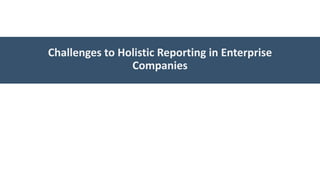Challenges to Holistic Reporting in Enterprise Companies
- 1. Challenges to Holistic Reporting in Enterprise Companies
- 2. Form Submissions Where did they come from? Events SEO Email SEO, email and events represent the bulk of traffic to product pages; however, we are unable to track from submissions through SEO, individual email campaigns or individual events. Although we can track SEM accurately, it is generating extremely low traffic volumes. Fortunately, most of the challenges listed in the following slides can be resolved through education, process improvement, and technical enhancements.
- 3. Form Submissions Where did they come from? Events SEO Email For Example: SEO produced 11,070 visitors, of which 107 submitted ŌĆśContact UsŌĆÖ forms for Remedy OnDemand. The top 2 email lead generation campaigns for Product X produced 634 ŌĆśContact UsŌĆÖ forms and 2,893 trial forms, which accounted for 57% of all trial form submissions during the last month suggesting the new email campaigns are working very well. With additional resources, process and education we will have a clearer view into how well individual marketing efforts are performing.
- 4. ŌĆó No centralized or team co-op holistic reporting - ŌĆ£We donŌĆÖt handle that.ŌĆØ ŌĆó Stakeholders feel overwhelmed with data; want to understand the true conversion metrics for channels and campaigns. ŌĆó Email campaigns arenŌĆÖt tested much or often. Split testing is only used for testing subject lines. ŌĆó Existing technical challenges for tracking form submissions accurately for email campaigns. ŌĆó Murky traffic volume data for email and SEO activities. ŌĆó Reporting duties are being consolidated, not integrated across teams. ŌĆó Reports are created in silos and other teams arenŌĆÖt utilized for data gathering. ŌĆó Limited access to reporting tools creates limited visibility, causing confusion for stakeholders to know what data to ask for or why. ŌĆó Non-standardized reporting templates and metrics. For example, form submissions are calculated in different ways.
- 5. ŌĆó No analytics governance ŌĆō forms and pages are created and retired without thinking of tracking consequences. ŌĆó Form creation errors ŌĆō forms are created with the same name on different pages making it impossible to track form submissions for a singular page. ŌĆó Analytics are not considered in the design process causing some calls to action elements to go untracked. ŌĆó Tracking tool limitations ŌĆō podcasts canŌĆÖt be tracked accurately, neither can the length of a video play. ŌĆó Lack of understanding who to turn to ŌĆō ŌĆ£I donŌĆÖt know. It might beŌĆ”ŌĆØ ŌĆó Stakeholders are unsure of what they want to use analytics for and require a lot of education. ŌĆó Fear of guesstimating conversion metrics ŌĆō ŌĆ£We canŌĆÖt track conversions.ŌĆØ ŌĆó Media channels are not compared side-by-side. ŌĆó Similar email campaign types are not compared against each other.
- 6. Web Page Design ŌĆó Analytics is an afterthought in the design process, causing some key elements to remain untracked. Email Campaign Creation ŌĆó Campaigns and forms are retired or changed, causing data disruption or eliminating tracking completely. Email Types ŌĆó Not all campaigns have the same goals so they canŌĆÖt be compared side-by-side, however similar campaigns can be but arenŌĆÖt. Program Association ŌĆó Some email campaigns contain links to multiple pages, causing difficulty in deciphering how much email traffic is being generated at the page level. Delivery ŌĆó Traffic goes to the main product pages as well as other pages making it difficult to determine how much total email traffic was driven to a particular page. Form Tracking ŌĆó The main form on product pages are not distinguishing email traffic from other traffic. The only forms that accurately track email traffic are forms embedded in emails or other pages tied to the email campaign.
- 7. Email Campaign in Eloqua ŌĆóUsers receive an email tied to an up-sell email campaign for main product ŌĆóUserŌĆÖs profile is stored in Salesforce.com which is integrated with Eloqua ŌĆóUser click on a link in the email and goes toŌĆ”. Web Form in Eloqua ŌĆó User arrives on a form page tied to the up-sell email campaign ŌĆóUser chooses to click on a link to the gateway page rather than fill out the form Gateway Page in Clickability ŌĆóUser clicks on a link to the main contact us form on the product page Main Contact Us Form in Eloqua ŌĆóUser fills out the main contact us form and clicks submit and goes to theŌĆ” Thank You Page in Clickability ŌĆóUser exits the site after filling out the main form. Summary: ŌĆó Although Eloqua can track specific forms that are tied to email campaigns (such as the Web Form in Eloqua above) it cannot track users from the more important main contact form or from the up-sell campaigns. ŌĆó Omniture can track user activities after the user arrives at the site but it cannot track where users came from. Therefore, it cannot determine which email campaign was most effective. Consider integrating Omniture with Eloqua. TrackingbeginsforOmniture andup-sellemailcampaignin Eloqua Formtrackingendsfortheup- sellcampaigninEloqua TrackingendsforOmniture andtheup=sellcampaignin Eloqua







